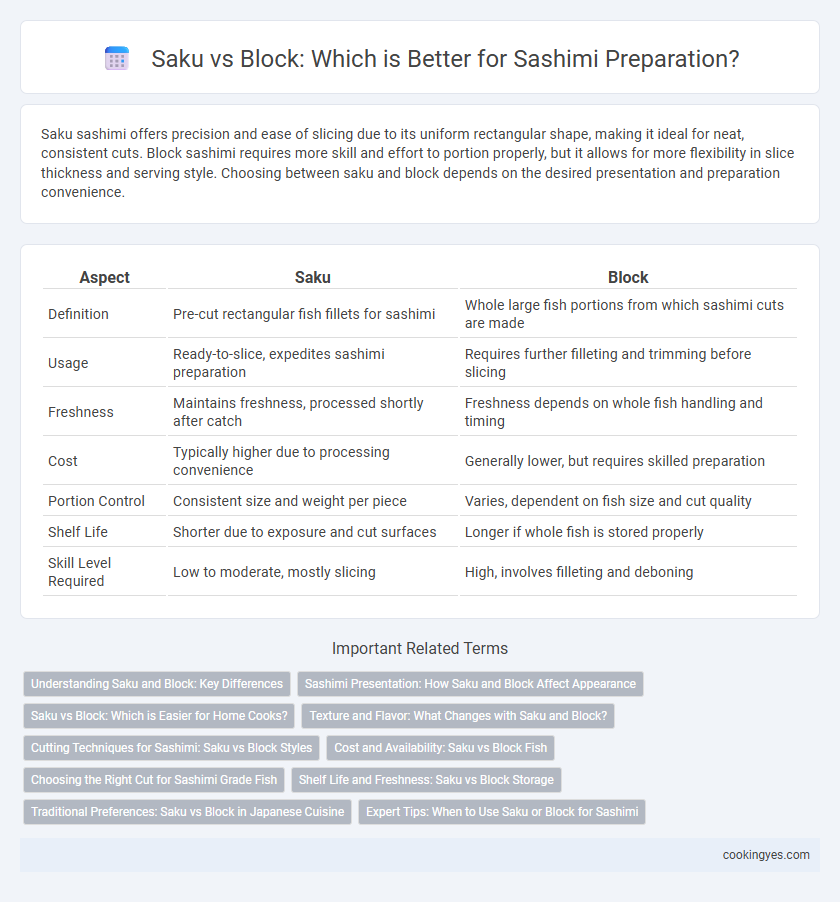Saku sashimi offers precision and ease of slicing due to its uniform rectangular shape, making it ideal for neat, consistent cuts. Block sashimi requires more skill and effort to portion properly, but it allows for more flexibility in slice thickness and serving style. Choosing between saku and block depends on the desired presentation and preparation convenience.
Table of Comparison
| Aspect | Saku | Block |
|---|---|---|
| Definition | Pre-cut rectangular fish fillets for sashimi | Whole large fish portions from which sashimi cuts are made |
| Usage | Ready-to-slice, expedites sashimi preparation | Requires further filleting and trimming before slicing |
| Freshness | Maintains freshness, processed shortly after catch | Freshness depends on whole fish handling and timing |
| Cost | Typically higher due to processing convenience | Generally lower, but requires skilled preparation |
| Portion Control | Consistent size and weight per piece | Varies, dependent on fish size and cut quality |
| Shelf Life | Shorter due to exposure and cut surfaces | Longer if whole fish is stored properly |
| Skill Level Required | Low to moderate, mostly slicing | High, involves filleting and deboning |
Understanding Saku and Block: Key Differences
Saku refers to pre-sliced, rectangular portions of fish fillets specifically prepared for sashimi, offering uniform size and ease of handling for precise cuts. Block, on the other hand, denotes larger, uncut fish fillet pieces requiring further trimming and slicing before sashimi presentation, allowing greater customization but demanding skilled knife work. Selecting between Saku and Block impacts preparation efficiency, consistency, and the final sashimi experience in terms of texture and appearance.
Sashimi Presentation: How Saku and Block Affect Appearance
Saku cuts produce uniform, rectangular slices that enhance sashimi presentation with clean, consistent edges, emphasizing the fish's natural texture and color. Block cuts offer thicker, more rustic pieces that highlight the freshness and marbling, appealing to a traditional, artisanal aesthetic. Choosing between saku and block influences the visual appeal, as saku favors precision and elegance while block favors authenticity and boldness.
Saku vs Block: Which is Easier for Home Cooks?
Saku cuts are easier for home cooks to handle due to their uniform, boneless rectangular shape, which simplifies slicing consistent sashimi pieces. Blocks often require additional trimming and deboning, making the preparation process more time-consuming and technically challenging. Choosing saku cuts saves effort and ensures cleaner, more uniform sashimi presentation for beginners.
Texture and Flavor: What Changes with Saku and Block?
Saku cuts, pre-sliced into rectangular portions, enhance sashimi texture by ensuring uniform thickness and smooth, clean edges that improve tenderness and mouthfeel. In contrast, block cuts retain the whole fish muscle, offering denser texture with subtly varied firmness and richer, more concentrated flavor due to less surface exposure. Using saku optimizes flavor absorption and presentation consistency, while block sashimi delivers a traditional experience emphasizing natural taste complexity and textural contrast.
Cutting Techniques for Sashimi: Saku vs Block Styles
Saku style sashimi involves neatly trimmed, uniform rectangular portions of fish that enhance precision and ease of slicing, ensuring consistent thickness for optimal texture and flavor. Block style sashimi is served as a whole fillet section, requiring skillful cutting directly from the block to maintain the fish's natural integrity, often yielding varied slice sizes that emphasize artisanal craftsmanship. Mastery of these cutting techniques impacts the sashimi's presentation and mouthfeel, highlighting the importance of knife control and understanding the fish's muscle structure.
Cost and Availability: Saku vs Block Fish
Saku fish, pre-cut into uniform portions, offers cost efficiency by reducing waste and simplifying inventory management compared to large block fish, which require skilled butchering and can lead to higher labor costs. Availability of saku is generally more consistent in markets supplying sushi-grade seafood, making it a preferred option for restaurants aiming to streamline sashimi preparation. Block fish, while potentially cheaper per pound, often demands additional processing time and expertise, impacting overall cost-effectiveness and timely availability.
Choosing the Right Cut for Sashimi Grade Fish
Selecting the right cut for sashimi-grade fish hinges on understanding the difference between saku and block cuts. Saku cuts, typically rectangular and uniform, are preferred for their consistent texture and ease of slicing into thin, precise pieces essential for sashimi presentation. Block cuts, larger and less uniform, require additional trimming and skill to prepare, making saku the optimal choice for maintaining freshness and achieving the desired delicate texture.
Shelf Life and Freshness: Saku vs Block Storage
Sashimi saku offers superior shelf life and freshness compared to block storage by minimizing exposure and reducing oxidation, which preserves the fish's delicate texture and flavor longer. Saku-cut portions are individually trimmed and vacuum-sealed, preventing bacterial growth and maintaining optimal freshness for up to 5 days under proper refrigeration. In contrast, block storage involves larger, untrimmed sections that are more susceptible to surface degradation and spoilage, significantly shortening shelf life and diminishing quality.
Traditional Preferences: Saku vs Block in Japanese Cuisine
Traditional Japanese cuisine favors saku over block cuts for sashimi preparation due to its optimal size, ease of portioning, and uniform texture, which enhance presentation and flavor. Saku cuts, typically rectangular fillets trimmed from whole fish, allow chefs to maintain freshness and precision, facilitating delicate slicing techniques integral to authentic sashimi. In contrast, block cuts are larger and less refined, often requiring further trimming and risking uneven texture, making saku the preferred standard in high-quality sashimi servings.
Expert Tips: When to Use Saku or Block for Sashimi
Saku cuts offer precision and consistency, making them ideal for premium sashimi where texture and uniformity are paramount. Block cuts preserve the fish's freshness longer and are preferred for larger portions, allowing chefs to slice sashimi as needed. Expert sashimi preparation balances sashimi-grade fish quality with the timing demands of service, choosing saku for immediate plating and block for extended storage without compromising flavor.
Saku vs Block for sashimi preparation Infographic

 cookingyes.com
cookingyes.com